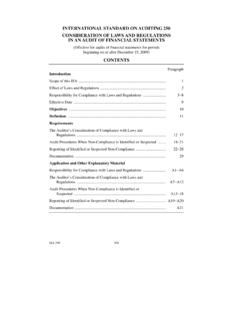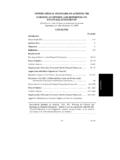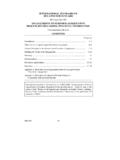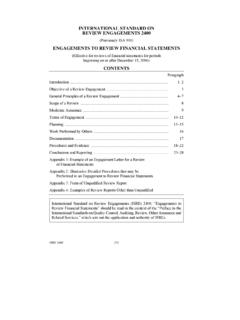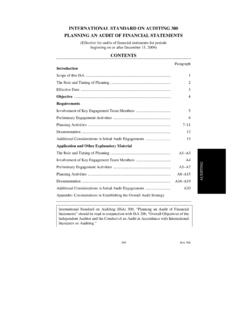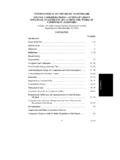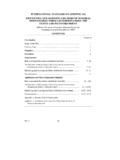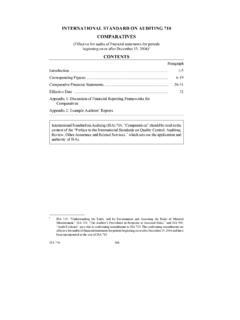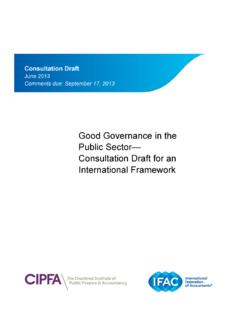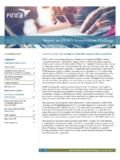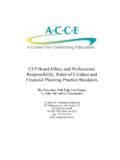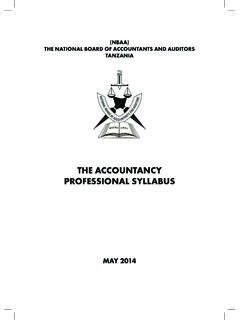Transcription of THE EXAMINATION OF PROSPECTIVE FINANCIAL …
1 ASSURANCE. INTERNATIONAL STANDARD ON. ASSURANCE ENGAGEMENTS 3400. (Previously ISA 810). THE EXAMINATION OF PROSPECTIVE . FINANCIAL information . (This Standard is effective). CONTENTS. Paragraph Introduction .. 1 7. The Auditor's Assurance Regarding PROSPECTIVE FINANCIAL information .. 8 9. Acceptance of Engagement .. 10 12. Knowledge of the Business .. 13 15. Period Covered .. 16. EXAMINATION Procedures .. 17 25. Presentation and Disclosure .. 26. Report on EXAMINATION of PROSPECTIVE FINANCIAL information .. 27 33. International Standard on Assurance Engagements (ISAE) 3400, The EXAMINATION of PROSPECTIVE FINANCIAL information should be read in the context of the Preface to the International Standards on Quality Control, Auditing, Review, Other Assurance and Related Services, which sets out the application and authority of ISAEs.
2 311 ISAE 3400. THE EXAMINATION OF PROSPECTIVE FINANCIAL information . Introduction 1. The purpose of this International Standard on Assurance Engagements (ISAE). is to establish standards and provide guidance on engagements to examine and report on PROSPECTIVE FINANCIAL information including EXAMINATION procedures for best-estimate and hypothetical assumptions. This ISAE does not apply to the EXAMINATION of PROSPECTIVE FINANCIAL information expressed in general or narrative terms, such as that found in management's discussion and analysis in an entity's annual report, though many of the procedures outlined herein may be suitable for such an EXAMINATION . 2. In an engagement to examine PROSPECTIVE FINANCIAL information , the auditor should obtain sufficient appropriate evidence as to whether: (a) Management's best-estimate assumptions on which the PROSPECTIVE FINANCIAL information is based are not unreasonable and, in the case of hypothetical assumptions, such assumptions are consistent with the purpose of the information .
3 (b) The PROSPECTIVE FINANCIAL information is properly prepared on the basis of the assumptions;. (c) The PROSPECTIVE FINANCIAL information is properly presented and all material assumptions are adequately disclosed, including a clear indication as to whether they are best-estimate assumptions or hypothetical assumptions; and (d) The PROSPECTIVE FINANCIAL information is prepared on a consistent basis with historical FINANCIAL statements, using appropriate accounting principles. 3. PROSPECTIVE FINANCIAL information means FINANCIAL information based on assumptions about events that may occur in the future and possible actions by an entity. It is highly subjective in nature and its preparation requires the exercise of considerable judgment. PROSPECTIVE FINANCIAL information can be in the form of a forecast, a projection or a combination of both, for example, a one year forecast plus a five year projection.
4 4. A forecast means PROSPECTIVE FINANCIAL information prepared on the basis of assumptions as to future events which management expects to take place and the actions management expects to take as of the date the information is prepared (best-estimate assumptions). 5. A projection means PROSPECTIVE FINANCIAL information prepared on the basis of: (a) Hypothetical assumptions about future events and management actions which are not necessarily expected to take place, such as when some entities are in a start-up phase or are considering a major change in the nature of operations; or ISAE 3400 312. THE EXAMINATION OF PROSPECTIVE FINANCIAL information . ASSURANCE. (b) A mixture of best-estimate and hypothetical assumptions. Such information illustrates the possible consequences as of the date the information is prepared if the events and actions were to occur (a what-if.)
5 Scenario). 6. PROSPECTIVE FINANCIAL information can include FINANCIAL statements or one or more elements of FINANCIAL statements and may be prepared: (a) As an internal management tool, for example, to assist in evaluating a possible capital investment; or (b) For distribution to third parties in, for example: A prospectus to provide potential investors with information about future expectations. An annual report to provide information to shareholders, regulatory bodies and other interested parties. A document for the information of lenders which may include, for example, cash flow forecasts. 7. Management is responsible for the preparation and presentation of the PROSPECTIVE FINANCIAL information , including the identification and disclosure of the assumptions on which it is based. The auditor may be asked to examine and report on the PROSPECTIVE FINANCIAL information to enhance its credibility whether it is intended for use by third parties or for internal purposes.
6 The Auditor's Assurance Regarding PROSPECTIVE FINANCIAL information 8. PROSPECTIVE FINANCIAL information relates to events and actions that have not yet occurred and may not occur. While evidence may be available to support the assumptions on which the PROSPECTIVE FINANCIAL information is based, such evidence is itself generally future oriented and, therefore, speculative in nature, as distinct from the evidence ordinarily available in the audit of historical FINANCIAL information . The auditor is, therefore, not in a position to express an opinion as to whether the results shown in the PROSPECTIVE FINANCIAL information will be achieved. 9. Further, given the types of evidence available in assessing the assumptions on which the PROSPECTIVE FINANCIAL information is based, it may be difficult for the auditor to obtain a level of satisfaction sufficient to provide a positive expression of opinion that the assumptions are free of material misstatement.
7 Consequently, in this ISAE, when reporting on the reasonableness of management's assumptions the auditor provides only a moderate level of assurance. However, when in the auditor's judgment an appropriate level of satisfaction has been obtained, the auditor is not precluded from expressing positive assurance regarding the assumptions. 313 ISAE 3400. THE EXAMINATION OF PROSPECTIVE FINANCIAL information . Acceptance of Engagement 10. Before accepting an engagement to examine PROSPECTIVE FINANCIAL information , the auditor would consider, amongst other things: The intended use of the information ;. Whether the information will be for general or limited distribution;. The nature of the assumptions, that is, whether they are best-estimate or hypothetical assumptions;. The elements to be included in the information ; and The period covered by the information .
8 11. The auditor should not accept, or should withdraw from, an engagement when the assumptions are clearly unrealistic or when the auditor believes that the PROSPECTIVE FINANCIAL information will be inappropriate for its intended use. 12. The auditor and the client should agree on the terms of the engagement. It is in the interests of both entity and auditor that the auditor sends an engagement letter to help in avoiding misunderstandings regarding the engagement. An engagement letter would address the matters in paragraph 10 and set out management's responsibilities for the assumptions and for providing the auditor with all relevant information and source data used in developing the assumptions. Knowledge of the Business 13. The auditor should obtain a sufficient level of knowledge of the business to be able to evaluate whether all significant assumptions required for the preparation of the PROSPECTIVE FINANCIAL information have been identified.
9 The auditor would also need to become familiar with the entity's process for preparing PROSPECTIVE FINANCIAL information , for example, by considering the following: The internal controls over the system used to prepare PROSPECTIVE FINANCIAL information and the expertise and experience of those persons preparing the PROSPECTIVE FINANCIAL information . The nature of the documentation prepared by the entity supporting management's assumptions. The extent to which statistical, mathematical and computer-assisted techniques are used. The methods used to develop and apply assumptions. The accuracy of PROSPECTIVE FINANCIAL information prepared in prior periods and the reasons for significant variances. ISAE 3400 314. THE EXAMINATION OF PROSPECTIVE FINANCIAL information . ASSURANCE. 14. The auditor should consider the extent to which reliance on the entity's historical FINANCIAL information is justified.
10 The auditor requires a knowledge of the entity's historical FINANCIAL information to assess whether the PROSPECTIVE FINANCIAL information has been prepared on a basis consistent with the historical FINANCIAL information and to provide a historical yardstick for considering management's assumptions. The auditor will need to establish, for example, whether relevant historical information was audited or reviewed and whether acceptable accounting principles were used in its preparation. 15. If the audit or review report on prior period historical FINANCIAL information was other than unmodified or if the entity is in a start-up phase, the auditor would consider the surrounding facts and the effect on the EXAMINATION of the PROSPECTIVE FINANCIAL information . Period Covered 16. The auditor should consider the period of time covered by the PROSPECTIVE FINANCIAL information .
